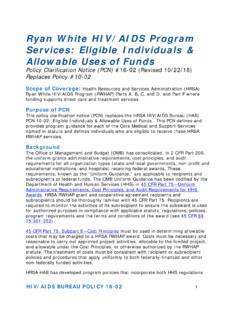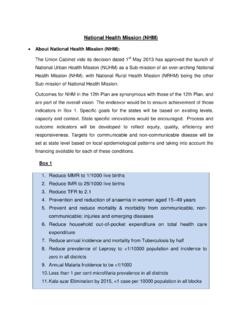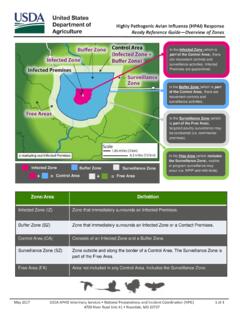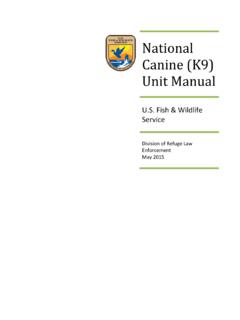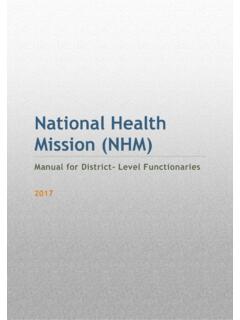Transcription of Clinical Quality Management Policy Clarification Notice
1 Clinical Quality Management Policy Clarification Notice Policy Clarification Notice (PCN) #15-02 (updated 09/01/2020). Replaces Policy Notice 11-04. Scope of Coverage health Resources and Services Administration (HRSA) HIV/AIDS Bureau (HAB) Ryan White HIV/AIDS Program (RWHAP) Parts A, B, C, and D. Purpose of PCN. The purpose of this PCN is to clarify the HRSA RWHAP expectations for Clinical Quality Management (CQM) programs . Background Title XXVI of the PHS Act RWHAP Parts A D 1 establishes requirements for Clinical Quality Management (CQM). For RWHAP Part A and Part B recipients, these requirements include a cap on CQM costs not to exceed the lesser of 5 percent of the amount received under the grant or $3 million. RWHAP Part C and Part D. recipient CQM costs must be reasonable. RWHAP Parts A D are required to establish a CQM program to: Assess the extent to which HIV health services provided to patients under the grant are consistent with the most recent Public health Service guidelines (otherwise known as the HHS guidelines) for the treatment of HIV disease and related opportunistic infections; and Develop strategies for ensuring that such services are consistent with the guidelines for improvement in the access to and Quality of HIV.
2 Services. It is the responsibility of the RWHAP recipient to work directly with their subrecipients to provide overall direction and to implement, monitor and exchange any needed data for performance measure data and/or Quality improvement activities. health care's adaptation of continuous Quality improvement and total Quality Management techniques from manufacturing began nearly 50 years ago with much momentum in the ,3,4 Over the years since, a large body of evidence has emerged suggesting that a robust and effective CQM program 1. Title XXVI of the Public health Service (PHS) Act 2604(h)(5), 2618(b)(3)(E), 2664(g)(5), and 2671(f)(2). 2. Donabedian A. Evaluating Quality of medical care. Milbank Q. 1966; 44:166 206. 3. Donabedian A. Exploration of Quality assessment and monitoring. Vols 1, 2, 3. Ann Arbor, Michigan: health Administration Press, 1980. 4. Berwick DM. Continuous improvement as an ideal in health care. N Engl J Med 1989; 320: 53-6.
3 2. HIV/AIDS Bureau Policy 15-02 1. contributes to overall improvements in the delivery of Quality health care. Coordination of CQM program activities is encouraged across all RWHAP funded recipients and subrecipients within a service area to maximize the impact of improved health outcomes and to support a reduction in data burden and alignment of performance measurement. Components of a CQM Program A CQM program is the coordination of activities aimed at improving patient care, health outcomes, and patient satisfaction. To be effective, a CQM program requires: Specific aims based in health outcomes;. Support by identified leadership;. Accountability for CQM activities;. Dedicated resources; and Use of data and measurable outcomes to determine progress and make improvements to achieve the aims cited above. CQM activities should be continuous and fit within and support the framework of grant functions. Recipients are strongly encouraged to use the National HIV/AIDS Strategy 5 (NHAS 2020) to frame CQM activities and goals.
4 In order to develop a CQM program that improves patient care, health outcomes, and patient satisfaction, certain components are necessary. These necessary components are Infrastructure, Performance Measurement and Quality Improvement. Each of these components have a distinct role in the overall CQM. program. All are important to implement a comprehensive CQM program that is able to meet established goals. Recipients may choose to have subcontracts for some or all of their CQM activities. Recipients may also work collaboratively with their stakeholders such as planning councils/planning bodies, governing bodies, and/or board of directors, as appropriate. Whatever mechanism is used, the recipient is ultimately responsible for ensuring that the CQM program meets HRSA's requirements for the RWHAP Parts. Infrastructure Appropriate and sufficient infrastructure is needed to make the CQM program successful and sustainable. Infrastructure is needed to plan, implement, and evaluate CQM program activities.
5 RWHAP grant funds can be used to establish an appropriate infrastructure for a CQM program. An ideal infrastructure consists of: Leadership: Leadership to guide, endorse, support, and champion the 5. National HIV/AIDS Strategy. The White House. Accessed at response/national-hiv- aids-strategy/nhas-update HIV/AIDS Bureau Policy 15-02 2. CQM program Committee: A CQM committee that develops the CQM program and corresponding activities Dedicated Staffing: Staff who are responsible for CQM duties and resources, as well as any contractors that may be funded to assist with CQM work Dedicated Resources: Funding that is adequate for CQM infrastructure and activities. Allowable CQM costs include training and capacity building to recipients and subrecipients on CQM; membership dues for CQM-related professional organizations; Quality -related certification, recertification, and continuing education) and the cost to implement CQM activities ( , collecting performance measurement data).
6 Clinical Quality Management Plan: A Clinical Quality Management plan that describes all aspects of the CQM program including infrastructure, priorities, performance measures, Quality improvement activities, action plan with a timeline and responsible parties, and evaluation of the CQM program People with HIV Involvement: Involvement of people with HIV that reflect the population being served to help ensure that the needs of people with HIV are being addressed by CQM activities Stakeholder Involvement: Stakeholder involvement ( , subrecipients, other recipients in region, planning body members and/or its committee members) that provides input on CQM activities to be undertaken CQM Program Evaluation: A plan that evaluates the effectiveness of the CQM. program to ensure that the CQM activities are making changes that positively affect outcomes. This evaluation includes assessing whether CQM program activities have been implemented as prescribed by the Quality Management plan (including the action plan).
7 Recipients should regularly evaluate their CQM activities in order to maximize the impact of the program. Evaluation provides the opportunity to learn the processes and resources needed in implementing CQM activities through the collection of detailed information. Part of the evaluation should include identifying factors ( , staff acceptance of change, improved Clinical performance) that affect the Quality improvement activities. Evaluation also identifies effective improvement strategies that can be scaled up or implemented in other facets within a system of care. Additional elements of an evaluation include effectiveness of the team and its ability to meet timelines and deliverables as described in the action plan in order to determine the success of the planned process. Although the infrastructure will vary in scope among recipients, the inclusion of all these elements creates a strong foundation for the CQM program. Performance Measurement Performance measurement is the process of collecting, analyzing, and reporting data regarding patient care, health outcomes on an individual or population level, HIV/AIDS Bureau Policy 15-02 3.
8 And patient satisfaction. In order to appropriately assess outcomes, measurement must occur. Measures should be selected that best assess the services the recipient is funding and that reflect local HIV epidemiology and identified needs of people with HIV. Recipients are strongly encouraged to include HRSA HIV/AIDS Bureau measures6 and NHAS indicators 7 that align with the national goals to end the HIV epidemic. Percent of RWHAP eligible clients receiving at least Minimum number of one unit of service for a RWHAP-funded service performance measures Category >=50% 2. >15% to <50% 1. <=15% 0. Recipients should identify at least two performance measures for the RWHAP. service categories (funded by direct RWHAP funds, rebates, and/or program income) where greater than or equal to 50% of the recipients' eligible clients receive at least one unit of service. Recipients should identify at least one performance measure for RWHAP service categories (funded by direct RWHAP.)
9 Funds, rebates, and/or program income) where greater than 15% and fewer than 50% of the recipients' eligible clients receive at least one unit of service. Recipients do not need to identify a performance measure for RWHAP service categories (funded by direct RWHAP funds, rebates, and/or program income). where fewer than or equal to 15% of the recipients' eligible clients receive at least one unit of service. Recipients should analyze performance measure data to assess Quality of care and health disparities and use the performance measure data to inform Quality improvement activities. Recipients should have an established process to collect and analyze ( calculate the numerator, denominator, and percentage). performance measure data at least quarterly. 8,9. Quality Improvement Quality improvement entails the development and implementation of activities to make changes to the program in response to the performance data results. To do 6.
10 HIV/AIDS Bureau HIV Performance Measures. 2018. Accessed at 7. HIV/AIDS Strategy: Updated to 2020 Indicators of Progress. Accessed at 8. Institute for Healthcare Improvement. How to Improve. Accessed at 9. Joint Commission. Tools for Performance Measurement in health Care: a Quick Reference Guide. Access at HIV/AIDS Bureau Policy 15-02 4. this, recipients are required to implement Quality improvement activities aimed at improving patient care, health outcomes, and patient satisfaction. 10 Recipients are expected to implement Quality improvement activities using a defined approach or methodology ( , model for improvement 11, Lean12). Quality improvement activities should be implemented in an organized, systematic fashion. As a result, the recipient is able to understand if specific changes or improvements had a positive impact on patient health outcomes or were indicative of further necessary changes in RWHAP funded services. All Quality improvement activities should be documented.
